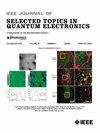Compact and Fully Functional High-Frequency Sine Wave Gating InGaAs/InP Single-Photon Detector Module
IF 4.3
2区 工程技术
Q1 ENGINEERING, ELECTRICAL & ELECTRONIC
IEEE Journal of Selected Topics in Quantum Electronics
Pub Date : 2024-12-25
DOI:10.1109/JSTQE.2024.3522205
引用次数: 0
Abstract
High-frequency sine wave gating (SWG) InGaAs/InP single-photon detectors (SPDs) are widely used for synchronous near-infrared single-photon detection. For practical use, the size of SPD is one of the most concerning features for system integration. Here we present, to the best of our knowledge, the most compact and fully functional high-frequency SWG InGaAs/InP SPD. We develop a sine wave gating integrated circuit (SWGIC) using system-in-package technology that supports functions including large amplitude sine wave gate generation, coincidence gate generation, phase regulation, amplitude monitoring, and amplitude modulation. Moreover, we design and fabricate a high-performance multi-mode fiber coupled InGaAs/InP single-photon avalanche diode (SPAD) with a compact butterfly package. Furthermore, we implement a monolithically integrated readout circuit (MIRC) to extract the weak avalanche signal from large capacitance response of SWG. Finally, the SWGIC, SPAD, MIRC, and the affiliated circuits are integrated into a single module with a size of 6 cm × 5.7 cm × 1.7 cm. After characterization, the SPD module exhibits a photon detection efficiency of 40%, a dark count rate of 9 kcps, and an afterpulse probability of 4.6% at an operation temperature of 238 K and a hold-off time of 160 ns. Our work provides a practical solution for applications necessitating highly integrated near-infrared single-photon detection.紧凑和全功能高频正弦波门控InGaAs/InP单光子探测器模块
高频正弦波门控InGaAs/InP单光子探测器(SPDs)广泛应用于同步近红外单光子探测。在实际应用中,SPD的尺寸是系统集成中最重要的特性之一。在这里,据我们所知,我们展示了最紧凑、功能齐全的高频SWG InGaAs/InP SPD。我们开发了一种正弦波门控集成电路(SWGIC),采用系统级封装技术,支持包括大振幅正弦波门生成、重合门生成、相位调节、幅度监测和幅度调制在内的功能。此外,我们设计并制造了一个高性能的多模光纤耦合InGaAs/InP单光子雪崩二极管(SPAD),具有紧凑的蝴蝶封装。此外,我们实现了一个单片集成读出电路(MIRC),从SWG的大电容响应中提取微弱的雪崩信号。最后,将SWGIC、SPAD、MIRC及其附属电路集成到一个尺寸为6 cm × 5.7 cm × 1.7 cm的模块中。经过表征,SPD模块在238 K的工作温度和160 ns的延迟时间下,光子探测效率为40%,暗计数率为9 kcps,后脉冲概率为4.6%。我们的工作为需要高度集成的近红外单光子探测的应用提供了一个实用的解决方案。
本文章由计算机程序翻译,如有差异,请以英文原文为准。
求助全文
约1分钟内获得全文
求助全文
来源期刊

IEEE Journal of Selected Topics in Quantum Electronics
工程技术-工程:电子与电气
CiteScore
10.60
自引率
2.00%
发文量
212
审稿时长
3 months
期刊介绍:
Papers published in the IEEE Journal of Selected Topics in Quantum Electronics fall within the broad field of science and technology of quantum electronics of a device, subsystem, or system-oriented nature. Each issue is devoted to a specific topic within this broad spectrum. Announcements of the topical areas planned for future issues, along with deadlines for receipt of manuscripts, are published in this Journal and in the IEEE Journal of Quantum Electronics. Generally, the scope of manuscripts appropriate to this Journal is the same as that for the IEEE Journal of Quantum Electronics. Manuscripts are published that report original theoretical and/or experimental research results that advance the scientific and technological base of quantum electronics devices, systems, or applications. The Journal is dedicated toward publishing research results that advance the state of the art or add to the understanding of the generation, amplification, modulation, detection, waveguiding, or propagation characteristics of coherent electromagnetic radiation having sub-millimeter and shorter wavelengths. In order to be suitable for publication in this Journal, the content of manuscripts concerned with subject-related research must have a potential impact on advancing the technological base of quantum electronic devices, systems, and/or applications. Potential authors of subject-related research have the responsibility of pointing out this potential impact. System-oriented manuscripts must be concerned with systems that perform a function previously unavailable or that outperform previously established systems that did not use quantum electronic components or concepts. Tutorial and review papers are by invitation only.
 求助内容:
求助内容: 应助结果提醒方式:
应助结果提醒方式:


